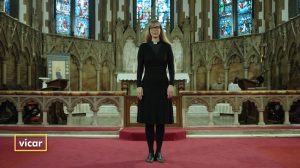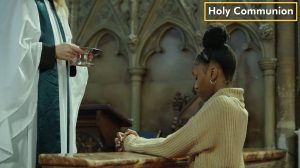Shanice takes us on a tour around an Anglican Church – pointing out the various features, explaining their meaning, and talking about her faith.
Curriculum Mapping
Component 1: The study of religions: beliefs, teaching and practices - Christianity - Worship and festivals - Prayer and its significance, including, set prayers and informal prayer. The role and meaning of the sacraments: •the meaning of sacrament •the sacrament of baptism and its significance for Christians; infant and believers' baptism; •different beliefs about infant baptism.
Area of Study 3 – Christianity - Section 3: Living the Christian Life - The role of the sacraments in Christian life and their practice in two denominations: the role of the sacraments/ordinance as a whole; the nature and importance of the meaning and celebration of baptism and the Eucharist in at least two denominations, including reference to the 39 Articles XXV-XXXVI; divergent Christian attitudes towards the use and number of sacraments in Orthodox, Catholic and Protestant traditions. The nature and purpose of prayer: the nature of and examples of the different types of prayer; set prayers; informal prayer and the Lord’s Prayer, including Matthew 6:5–14; when each type might be used and why; divergent Christian attitudes towards the importance of each type of prayer for Christians today.
Component Group 1 - Christianity - Practices - Sacraments• The meaning of the word sacrament • The role and meaning of the sacraments •The role of Baptism and Eucharist in the life of a Christian •Common and divergent attitudes towards the practice and meaning of Baptism by different Christian denominations •Common and divergent attitudes towards the practice and meaning of the Eucharist by different Christian denominations •Common and divergent attitudes towards the Sacraments,including which practices are considered by different Christian denominations to be a sacrament •Different interpretations and emphases given to sources of wisdom and authority by different Christian denominations
2.2 Unit 2 - PART A - Christianity - Core beliefs, teachings and practices -- Practices Life’s Journey: Sacraments and key acts of worship: Baptisms (Mark 1:9-11); Infant and Believers' Baptism; reasons and rituals Eucharist/Communion (1 Corinthians 11:23-26): diverse Christian interpretations and associated practices Confirmation - preparation and ceremony (Acts 2: 1-13) Significance of a religious wedding (Mark 10:7-9): matrimonial symbols and vows 2.1 Unit 1 PART A - Christianity - Core beliefs, teachings and practices - Practices - Church - Importance of prayer, communal and private - Matthew 6:5-13, Matthew 18:20
Component 2 (Route A) Study of Christianity: Practices: Sacraments ➢ Diverse beliefs regarding Sacraments ➢ The role, meaning and celebration of Baptism and Eucharist: John 3:3-6 ➢ Diverse interpretations of Baptism and Eucharist with reference to the beliefs of the Catholic and Protestant Churches Forms: Component 2 (Route B) Applied Catholic Theology : Theme 3: Life and Death: Artefacts: How Christian beliefs in the resurrection are expressed by the paschal candle as it is used in the Easter Vigil and during Catholic Baptism
Transcript
Holy Cribs Anglican Church
Shanice: Welcome to Saint Anne's Church! My name is Shanice and I'm a Christian. The church is where I come every Sunday to worship God, but there aren't any services going on at the moment, so I can show you around. Come in! Isn't it beautiful? The word 'church' can mean the building or the community of people who come here. So, the Church worships at the church. This is the main part of the building called the 'nave' - and in traditional churches like this one, it always faces east. If you could look at the church from above, you'd see that it's in the shape of a cross, the Christian symbol. Everyone sits in the nave looking east, so the main entrance to the church is usually at this end and it's called the West Door. The arms of the cross are called 'transepts'. So there's a north transept and a south transept. And the front of the church - the top of the cross - is called the 'chancel', and that's where the priest usually stands to lead a service. We have lots of names for a priest, but in the Church of England or the Anglican Church, we usually call the priest a 'vicar'. By the West Door, you'll often find one of these: a 'font'. It's a big stone basin which can be filled with water to baptize people at a special service. It happens when a baby is born and welcomed into the Church or when an older person becomes a Christian.
The vicar blesses the water and sprinkles it on the person's head. The font is near the door to symbolise that a person must be baptized before they can become a full member of the Church. When you come into the church, you walk down the aisle to find a seat. These long benches are called 'pews', although lots of churches just have ordinary chairs. In front of the pews you'll find these cushions called 'hassocks', which people kneel on when they pray. There's also these handy shelves, which people put their Bibles and hymn books on. So this is the centre of the cross shape. You have the north transept up there, and the south transept down there - and this is the 'chancel', the front of the church! During the service, someone will read to everyone from the Bible and this is done from a big book stand called a 'lectern', and in some churches it's in the shape of an eagle, and there are lots of stories to explain why. My favourite is that people used to think that the eagle was the bird that could fly the furthest and the highest in the sky, so it's a symbol that Christians believe that the words of God should be heard all over the world.
This little platform with stairs going up is called the 'pulpit'. The vicar or another member of the church gives a talk to everyone called a sermon, but now that we've got microphones, being up here isn't quite so important, so lots of people choose to speak from the front of the chancel here. This front part of the chancel is called the 'choir' because it's where the choir sits - or used to sit. Most churches had a choir to lead the singing of religious songs called hymns, but now we've got microphones this can be done by 1 or 2 people. In some churches, the hymns are sung along to the tunes played by a huge instrument called an 'organ'. It has keyboards like a piano, and it's noise is made from huge pipes and it can sound like a whole orchestra! But organs are very difficult to play... so lots of churches have bands playing guitars and pianos instead. Right at the front is the most important part of the church, and it's called the 'sanctuary' - it's separated from the rest of the church by a rail. And this table is called an 'altar' - you've got candles here, a special cup called a 'chalice' and a plate called a 'paten'. During a special service called Holy Communion, the vicar stands behind the altar, puts some bread onto the paten and pour some wine into the chalice. The vicar blesses them, and then everyone comes to the rail to eat a piece of bread and take a sip of the wine. We do this because Jesus asked us to. We believe that he died and came back to life so that we can all go to heaven. The wine symbolizes his blood, and the bread symbolizes his body. We all share them to remember that we are all part of the same community and will be together in heaven. Traditional churches like this one have stained glass windows to show scenes from the Bible. So that's it - that's my church! It's not just a place where people come to worship... During the week, there are nurseries for toddlers, after school clubs for young people, social clubs for old people and soup kitchens for the homeless. Most churches have a square tower or a pointy spire. They have bells which can be rung to let people know that the service is about to start. But the tower or the spire also shows people where the church is! So it can be, as it always was intended to be, at the centre of the community.
Thanks for coming! Bye!






